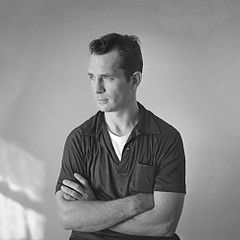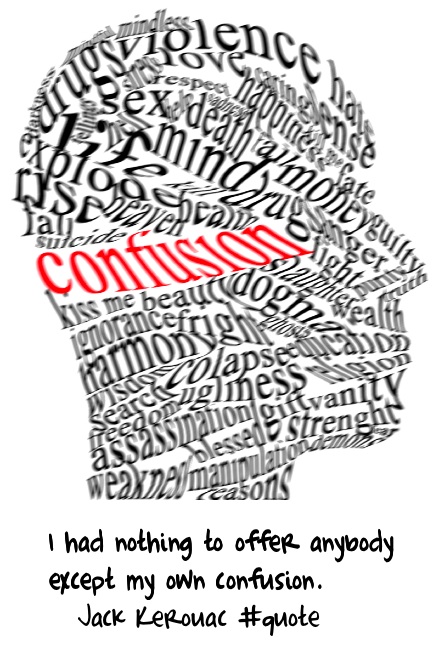 The following is excerpted from The Voice Is All: The Lonely Victory of Jack Kerouac
The following is excerpted from The Voice Is All: The Lonely Victory of Jack Kerouac,
published by Viking, 2012.
On October 7, 1951, after a gloomy Sunday when he seemed to be making no progress on the chapters about Neal Cassady he was adding to On the Road, Jack went to Birdland to hear the alto saxophonist Lee Konitz, who recently had come into his own as a leading innovator of cool jazz. During Konitz’s solo in “I Remember April,” which he played as if it were “the room he lived in,” his music sounded “so profoundly interior” to Jack that he was sure very few people would understand it. In fact, he compared Konitz’s extended phrases to the sentences he was writing lately, sentences whose direction seemed mysterious until the “solution” was suddenly unveiled in a way that shed light backward on everything that had preceded it. Admiring Konitz for refusing to make the concessions that would gain him a wider audience, Jack saw that both he and the musician were essentially doing the same thing — attempting to communicate “the unspeakable visions of the individual.” Grabbing a pencil, he scribbled a reminder to himself: “BLOW AS DEEP AS YOU WANT TO BLOW.” It was a rule he would start to follow in his work, despite his continued brooding about his tormenting inability to finish his second novel.
When Jack wasn’t writing in his cell-like basement room, he often roamed the surrounding streets of Richmond Hill, where one day he saw a crowd gathered in an empty lot. A bloody fetus had been found there, dumped into the weeds in a paper bag. Shaken, he returned home, his reeling thoughts terrifying him, for it seemed he could hold on to none of them, making him wonder about the effect alcohol was having on his brain. If his mind was going, how could he ever finish On the Road? Unable to calm himself, he broke down into a prayer for forgiveness. The dead baby apparently reminded him of his guilty role in the conception of the one his ex-wife was carrying. Even the look Jack had been unable to prevent himself from taking at the red flesh of the fetus seemed to contribute to his guilt. He spent the next couple of days convinced he was being punished for his sins by losing the ability to write.
On October 15, Jack was still in a state of panic when he met Ed White in a Chinese restaurant near Columbia. Although Ed assured him his block was only temporary, this did nothing to improve Jack’s mood. Changing the subject to his own work, Ed showed Jack the pocket sketchbook in which he had been making drawings of architectural details. This led him to an idea he thought Jack should try out — a way for him to ease back into writing: “Why don’t you sketch in the street like a painter, but with words?”
As an experiment in which nothing was really at stake, “sketching” immediately gave Jack what he most needed — the freedom to write his “interior music” just as it came to him, removing the inhibiting presence in his mind of the imaginary reader. He was about to discover what he had been looking for — a way to write passages in which he would seize the peak moment of initial inspiration and ride it through to the end, without interrupting the flow of imagery. Sketching would finally dissolve the barrier between poetry and prose.
The day after seeing Ed, Jack took a notebook and walked to Sutphin Boulevard, a skidrow-like area in working-class Jamaica, where he sketched two places that had a time-stopped feeling about them. The first was an old railroad-car diner permeated by a brown “FOODY” smell that reminded him in a Proustian way of the aroma of countless American diners, of parochial school and hospital kitchens, of greasy hamburger pans soaking in sinks. The next scene he colored in shades of gray, a dilapidated B-movie theater, adjoined by a filthy hotdog stand with its surrounding pavement littered with cigarette butts and chewing gum. No sign of entropy escaped Jack’s eye — he searched out the broken bulbs behind the holes in the glass facing of the Capricio Theater’s marquee, saw how the diner’s scarred wooden counter resembled “the bottoms of old courtroom benches.” Without knowing it, he had just written the opening of Visions of Cody. Somehow he’d been able to induce in himself an exceptional state of awareness that gave his portrayals of these scenes a heightened immediacy that went beyond realism.
The act of writing requires entry into a meditative state in which the tension between what the writers knows or feels and the peculiar need to put it into words upon a page can be resolved. But sketching demanded something more from Jack — abandonment to a “tranced fixation” on the object, a deeper way of dreaming upon what he saw. “Everything activates in front of you in myriad profusion,” he would explain to Allen Ginsberg, revealing that “sometimes I got so inspired I lost consciousness I was writing.” But there seemed to be an inherent danger in becoming what Yeats once called, “a man helpless before the contents of his own mind.” There began to be a palpable tension between the deepening melancholy that made Jack crave alcohol and the addictive exhilaration the intensification of his creative energy was giving him.
Meanwhile, not even alcohol could hold back the discoveries that were transforming his writing. On October 25th, he went to sketch the old Forty-seventh Street El station. In the men’s room, the way the yellow-painted walls contrasted with the dark brown woodwork and stamped tin ceiling summoned up a picture in Jack’s mind of the imitation wainscoting he’d noticed in flophouses out west. When he returned to Richmond Hill, after taking a long walk down the Bowery to Chinatown, he was able to resume his sketching, evoking images of what he’d seen during his walk with no loss of intensity. By the following night he was sure that the sketches in his notebook were far superior to all the “oil” painting he’d been doing for On the Road and that he’d just had the “greatest” of all his Octobers.
Joyce Johnson is widely known for Minor Characters, her memoir about growing up in the 50’s and her personal relationship with Kerouac, which won a National Book Critics Circle Award in 1983. The excerpt is from the latest of her eight books, The Voice Is All: The Lonely Victory of Jack Kerouac, which has just been published by Viking. The first biography to be based on the material in the Kerouac Archive, it looks at him as a Franco-American and as a bilingual American writer and tells his story with a focus upon the development of his work through 1951, the year he wrote On the Roadand began Visions of Cody.
 Jean-Louis “Jack” Lebris de Kerouac (play /ˈkɛruːæk/ or /ˈkɛrɵæk/; March 12, 1922 – October 21, 1969) was an American novelist and poet. He is considered a literary iconoclast and, alongside William S. Burroughs and Allen Ginsberg, a pioneer of the Beat Generation. Kerouac is recognized for his spontaneous method of writing, covering topics such as Catholic spirituality, jazz, promiscuity, Buddhism, drugs, poverty, and travel. His writings have inspired other writers, including Ken Kesey, Bob Dylan, Eddie Vedder, Richard Brautigan, Thomas Pynchon, Lester Bangs, Tom Robbins and Will Clarke. Kerouac became an underground celebrity and, with other beats, a progenitor of the Hippie movement, although he remained antagonistic toward it. In 1969, at age 47, Kerouac died from internal bleeding due to long-standing abuse of alcohol. Since his death Kerouac’s literary prestige has grown and several previously unseen works have been published. All of his books are in print today, among them: On the Road, Doctor Sax, The Dharma Bums, Mexico City Blues, The Subterraneans, Desolation Angels, Visions of Cody and Big Sur.
Jean-Louis “Jack” Lebris de Kerouac (play /ˈkɛruːæk/ or /ˈkɛrɵæk/; March 12, 1922 – October 21, 1969) was an American novelist and poet. He is considered a literary iconoclast and, alongside William S. Burroughs and Allen Ginsberg, a pioneer of the Beat Generation. Kerouac is recognized for his spontaneous method of writing, covering topics such as Catholic spirituality, jazz, promiscuity, Buddhism, drugs, poverty, and travel. His writings have inspired other writers, including Ken Kesey, Bob Dylan, Eddie Vedder, Richard Brautigan, Thomas Pynchon, Lester Bangs, Tom Robbins and Will Clarke. Kerouac became an underground celebrity and, with other beats, a progenitor of the Hippie movement, although he remained antagonistic toward it. In 1969, at age 47, Kerouac died from internal bleeding due to long-standing abuse of alcohol. Since his death Kerouac’s literary prestige has grown and several previously unseen works have been published. All of his books are in print today, among them: On the Road, Doctor Sax, The Dharma Bums, Mexico City Blues, The Subterraneans, Desolation Angels, Visions of Cody and Big Sur.
 The following is excerpted from
The following is excerpted from